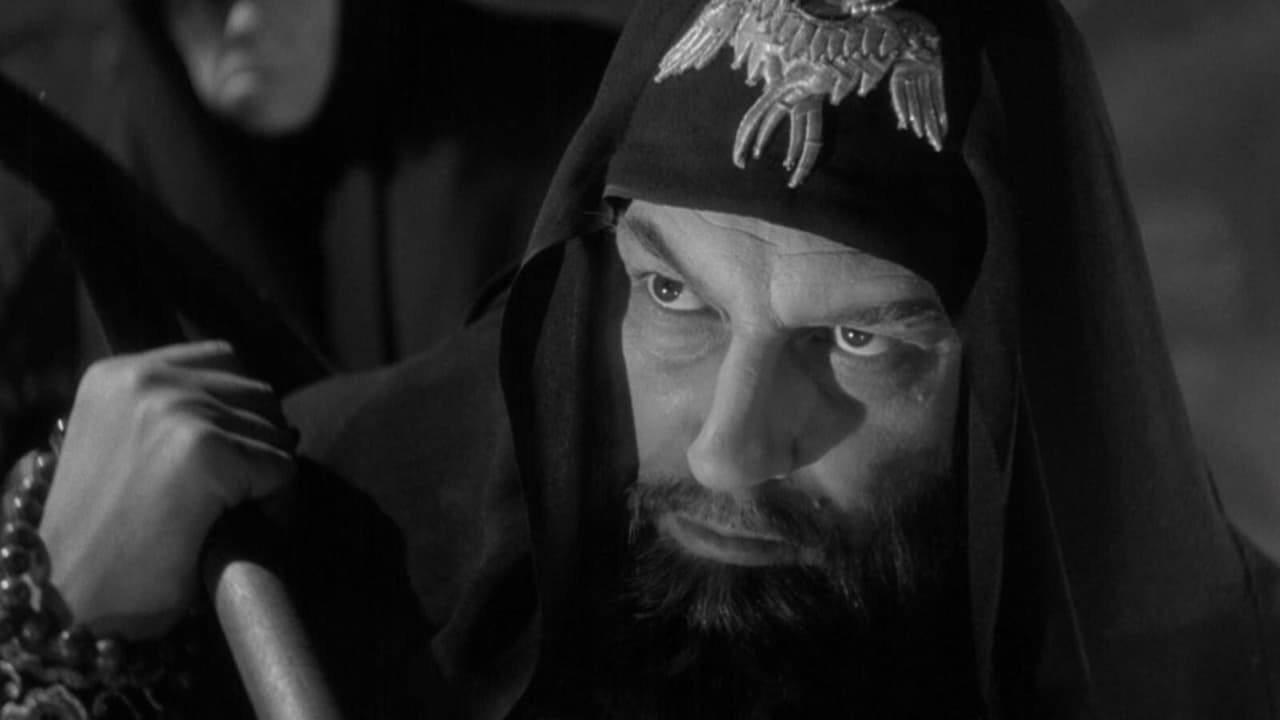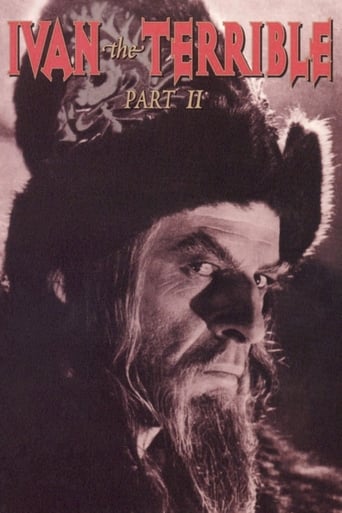

Waste of time
... View MoreLet's be realistic.
... View MoreInstant Favorite.
... View MoreAm I Missing Something?
... View MoreAlthough Eisenstein has never been among my favorite directors, I must admit his unfinished trilogy about Ivan the terrible proves his great talent, sincerity and bravery as a filmmaker.Part 2 of the trilogy was criticized by Stalin and banned, the production of part 3 was stopped.Stalin,who idealized Ivan 4 as a founder and a leader of a powerful Russian State, suggested(namely, ordered) Eisenstein the biopic about him. Eisenstein planned to make it as a trilogy to make from "ordered" subject matter cinematic works of art. As a whole trilogy must have been represent three stage of Ivan's life: the heroic youth of "Tsar of All Russia', his middle age with the suffering and the beginning of moral decline as a results of never-ending conspiracy, and the beginning of last period of his life with a massacre in Novgorod and battles in Livoian War,where all of his supporters were killed and he was left alone at last.I've recently read the scenario of part 3 and found there both apparent similarities with previous parts and logical development of the plot after the events depicted previously. Among these 3 parts, the plot of part 2 is the pivotal one, so the contrast with part 1 naturally turned out to be very keen, and probably that's why Stalin and his fellows saw in it unpleasant contradiction with heroic part1. The composition of the trilogy is so dramatic and complete in its tragic sense that somehow reminds me of "Godfather" trilogy, but it is based on historical facts. And author's intention seems to represent the tragic life of this unique historical person with no bias of propaganda. Eisenstein was so sincere as an artist that he couldn't simplify the complex and dramatic life of his hero. And he was so brave in front of real political power that no compromise was made in creating the most uneasy part 2.
... View More(Also see my review of Part I) Before viewing Part II, understand the term "Zemshchina".Everything is stylized. Don't though write off the acting style as hopelessly old fashioned; in the end it's quite effective. Figurative paintings decorate many of the walls; nearly every scene looks like an example of "icon painting".Shadows are used a lot: emphasize the action, or show a possible alternate reality, or portray a character's inner thoughts, or foreshadow, or undercut the action's meaning, or suggest madness.Part II is mostly B&W like Part I, but with a couple fairly short color sections. Eisenstein emphasized red and green/blue/black. Although the use of color was experimental, it's surprisingly effective.Ther's lots of cuts to other people, different vantage points, closeups, shifts to stay with the action, and so forth. But the camera only moves between shots; there aren't any dolly shots or rack focus, and arguably no tracking shots.Soviet Realism wanted films to be so simple -with few stylistic "tricks"- they could be apprehended by anyone. So Eisenstein wasn't allowed to use his own "montage" techniques. He nevertheless snuck in comparisons big-time. Comparisons are prompted when dialog and actions don't quite match; when different characters assume the same odd posture; between the real humans and the wall paintings; between film scenes and well-known paintings, between two different characters in the same frame; between characters and objects; and even between almost identical scenes several minutes apart.It's well known that Part I won the "Stalin Prize", Part II was completed but then put "on the shelf", and Part III canceled. The content of the films don't explain why; Ivan's worst abuses are never shown, and aren't even talked about much. There were significant censor-required changes even to Part I, and the Stalin Prize was hotly debated. The real difference was Part I was judged during WWII, Part II after its end.
... View MorePart 2 followed on from Part 1 without a gap the 2 put together would make one colossal movie. The only trouble being that the last 90 minutes or so would still be missing (Part 3). This has a 16 minute colour sequence near the end plus the last 2 minutes that added a new dimension to the story, and although the spotlighting was a bit ropey it all worked well with the usual fantastic camera angles and ugly brooding people.Ivan vacillates between doing it his way and relying on Mother Church for help. Either way the plotting aristocratic boyars have to be sorted out for once and for all, this he sets out to accomplish with the help of the Men Apart his NKVD. In reality Ivan was going mad at this period, the similarities to Stalin still resound. Eisenstein pulled his punches but must have known Part 2 would end up in trouble, which it did it wasn't released from the metaphorical gulag until 1958, and Part 3 was aborted. Intensely absorbing and startlingly melodramatic by turns it still hasn't got the same energy as Part 1, but that only makes it a lesser classic. Again, it resembles a sedate silent film with sound (with a bit of red this time), the simple tale powerfully told by a master propagandist using sledgehammer symbolism at every turn. Intelligent film-making is hardly the phrase to use a previous post compared Eisenstein correctly to Kurosawa very different styles but with the same results.Wonderful sequel, much better to be watched on the heels of Part 1. At least the people who didn't like that won't watch this and comment adversely on it, right?
... View MoreIvan Grosnyy, Part II is the movie of my life; the Part I is also a very good film. It is the masterpiece of Sergei Eisenstein. Unfortunately we can never see the Part III of this meant to be trilogy. The performances (especially Nikolai Cherkasov), the photography, the wardrobe, the scenarios and the shots are the most beautiful I have ever seen in the history of film-making. However, it is necessary to watch the Part I first to understand the history. I suggest to all the people who like this genre of film to see another very good film of Sergey Eisenstein: Alexander Nevsky once again with Nikolai Cherkasov in the main role. I recommend to all the people who want to see these movies to by the Criterion DVD box set, which contains also first part and, Alexander Nevsky. Don't die without seeing these masterpieces.
... View More